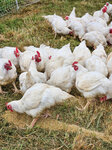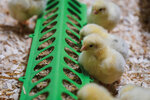


Alex Tappin at White Clover Farm in Battle Ground raises hundreds of soy-free chickens each year. His philosophy is that his food shouldn’t be eating ingredients he can’t consume.
Tappin, however, has struggled to process his poultry, despite the high demand.
“I am slightly allergic to soy, so I don’t eat soy,” Tappin said. “I figured if I’m not going to eat it, I don’t want my food eating it either.”
Tappin’s customers also want soy-free chicken for similar reasons, he said. He initially began raising chickens solely for his family but expanded operations to meet local demand.
“If I’m growing it, and all these other people want it, as well, I’ll just grow more,” Tappin said. “That was the drive and motivation to start this.”
Soy feed is ideal fodder, he said, and is known for being an inexpensive source of protein. Tappin encourages his birds to forage bugs for extra protein by feeding them only once daily.
“I find if you feed them once a day, they’ll find a lot more food on their own,” Tappin said.
White Clover Farm’s chickens are free range, kept in mobile electric pens, which protect the chickens from predators. Tappin moves the pens periodically to keep the chickens on fresh pasture filled with bugs, grasses and other plants. He also supplements their meals with a soy-free, non-genetically modified organism feed daily.
The broiler chickens, specifically bred and raised for meat, grow astonishingly fast, he said. The popular hybrid broiler Cornish cross breed reaches a slaughter weight of 3 to 4 pounds within just six weeks. Tappin lets his broilers grow more slowly by feeding them less.
“Some people say eight weeks, but we do ours for 10 to 12 just because I only feed them once a day. They’re not growing as fast,” Tappin said.
Though Tappin has raised heritage breed broiler chickens in the past, the hybrid broilers are extremely efficient. Their feed costs are low, they require little space, do minimal damage to the ground and grow fast enough that Tappin can raise 300 to 400 chickens per year.
“You can grow a lot of food pretty quickly. You don’t need as much space, and they’re not as destructive,” Tappin said. “I have a spot where I get the chicks and raise them for two to three weeks. Then we put them outside on grass.”
The greatest challenge for Tappin has not been raising the chickens but finding processing options. Few slaughterhouses are publicly available in Washington, Tappin said.
“Processing birds is the biggest hurdle. Washington state doesn’t have nearly enough processors for smaller farms like us. So, we either apply for the on-farm processing, which only allows you to sell for 48 hours after processing, or we take them to Oregon,” Tappin said.
If he processes on the farm, he is limited to selling whole birds due to licensing costs, Tappin said. When the chickens are slaughtered on the farm, they are sold whole in 4- to 6-pound bags.
Slaughtering in Oregon provides a little more flexibility because he has more time to sell the meat, Tappin said. Meat from chickens slaughtered in Oregon can only be sold there, unless they are processed in a USDA-certified processing facility.
Finding a publicly available USDA-certified processing plant in Oregon would let him legally sell in Washington and provide the most flexibility, Tappin said.
“This year, I’m still looking for a processor in Washington. Otherwise, I can only sell in Oregon. There’s processors all over the place in Oregon,” Tappin said. “There’s a lot of demand, but there’s not much processing.”
To learn more about White Clover Farm, visit whiteclover farming.com.